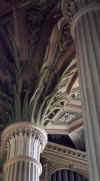|


| |
 |
Leipzig is the city in which Martin Luther and John
Eck debated in 1519. In Luther's day it was home to the prestigious
University of Leipzig and part of Albertine Saxony, under the rule of
Luther's enemy, Duke George. Photo A shows the French Baroque interior of
the St. Nicholas Church, where Luther no doubt preached sometime during
his various visits to the city. St. Nicholas church, however, is more
important for its part in more recent history. In 1989 the church's weekly
Monday prayer services became one of the major points of protest against
the communist government. Over 70,000 people came to the church for a
demonstration on October 9. On October 16 over 120,000 citizens gathered,
and two days later communist party chief Erich Honecker resigned. |
Facts and Photos
 Without
question Luther's most important visit to Leipzig was in 1519, when he debated
John Eck, theologian from the University of Ingolstadt. After much political
wrangling, the debate, which lasted several days, finally got underway with a
6:00 am opening mass at St. Thomas Church (photos B and C). St. Thomas is also
known for its most famous music director, J. S. Bach, who is buried in the
chancel. Without
question Luther's most important visit to Leipzig was in 1519, when he debated
John Eck, theologian from the University of Ingolstadt. After much political
wrangling, the debate, which lasted several days, finally got underway with a
6:00 am opening mass at St. Thomas Church (photos B and C). St. Thomas is also
known for its most famous music director, J. S. Bach, who is buried in the
chancel.
 The
debate group processed after mass to the Pleissenburg Castle, which was torn
down in the middle of the 16th century to make room for a new fortress. Although
Luther made many enemies and Eck used Luther's arguments in the debate as
ammunition for Pope Leo to issue the bull of excommunication against him, the
Leipzig debate was not a total disaster for Luther. Kittelson notes that after
the Leipzig debate Luther became the most famous man in Europe, and the number
of students at the fledgling (founded in 1502) University of Wittenberg grew so
great that the town could not house them all (145-6). The
debate group processed after mass to the Pleissenburg Castle, which was torn
down in the middle of the 16th century to make room for a new fortress. Although
Luther made many enemies and Eck used Luther's arguments in the debate as
ammunition for Pope Leo to issue the bull of excommunication against him, the
Leipzig debate was not a total disaster for Luther. Kittelson notes that after
the Leipzig debate Luther became the most famous man in Europe, and the number
of students at the fledgling (founded in 1502) University of Wittenberg grew so
great that the town could not house them all (145-6).
Reflections
While in Leipzig, the five of us (Mom, Dad, Richard and Miriam Carter, and
me) were the guests of friends of Richard and Miriam's daughter, who had studied
and lived in Leipzig as a Fulbright scholar. These friends were all members of
the SELK Lutheran congregation in Leipzig, an independent Lutheran body in
Germany with which the LCMS is in fellowship. My parents and I had been a little
hesitant about imposing on strangers, but it soon became clear that the
Haeffner's (the SELK pastor and his wife) and the Dicke family were genuinely
delighted to host us all. Our connection in Dresden was even more remote–at
the train station we were welcomed by Hans-Gert and Anarosen Daenel. Their
daughter had studied at Ohio State University, and a good friend of hers from
Ohio State was friends with a Concordia student; through this friend of a friend
of a student, Richard made arrangements with the parents, Hans-Gert and
Anarosen. They welcomed us, total strangers, into their home and lives, with a
genuine Christian hospitality that words cannot express. I believe their
openness toward us and willingness to do countless acts of kindness for all of
us during those few days and for me during my 8 weeks of study in Dresden–more
than I can begin to recount–is intimately connected with their understanding
of the Body of Christ. As professing Christians during communist rule in East
Germany, they suffered both economically and socially. Yet through those
experiences, they learned to value highly the fellowship shared by all
Christians; so we were to them not strangers, but brothers and sisters in
Christ. We in the USA, who often take for granted our religious freedom, do not
have the same depth of understanding or appreciation for our oneness in Christ
with other Christians around the world.
|
